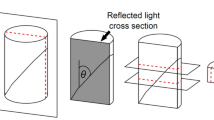Abstract
This experimental work aimed to identify local mechanisms in remoulded clays under different triaxial loading conditions. The behaviour at a given stress level reached by two different stress paths, i.e. the conventional constant σ′3 stress path and the purely deviatoric stress path, and the behaviour at two different stress levels along a given stress path were examined. The investigation concerned both normally consolidated and overconsolidated saturated specimens of remoulded kaolin clay. The microstructural states of the clay specimens induced by different triaxial loading paths were examined at two different scales using the scanning electron microscopy and the X-ray microtomography. The results highlighted five particle orientation modes that could be activated. These modes seem to be highly dependent on the stress level, the overconsolidation ratio and the stress path. Mesocracks were found to develop within strongly overconsolidated specimens accompanied by the occurrence of dilatancy. The proposed conceptual modes provide an interesting approach to understand the mechanical behaviour of remoulded clays, especially the macroscale dilatancy phenomenon, through the possible activation of different mechanisms at micro- and mesoscales.
























Similar content being viewed by others
References
Anandarajah A, Kuganenthira N, Zhao D (1996) Variation of fabric anisotropy of kaolinite in triaxial loading. J Geotech Eng 122(8):633–640
Bai X, Smart R (1997) Change in microstructure of kaolin in consolidation and undrained shear. Géotechnique 47(5):1009–1017
Barton CM (1974) The micromorphological soil investigation work of Dr. Lafeber. In: Rutherford GK (ed) Soil microscopy. The Limestone Press, Kingston, pp 1–19
Bésuelle P, Viggiani G, Desrues J, Coll C, Charrier P (2014) A laboratory experimental study of the hydromechanical behavior of boom clay. Rock Mech Rock Eng 47(1):143–155
Biarez J, Hicher PY (1994) Elementary mechanics of soils behaviour: saturated remoulded soils. AA Balkema, Rotterdam
Brochard L, Honório T, Vandamme M, Bornert M, Peigney M (2017) Nanoscale origin of the thermo-mechanical behavior of clays. Acta Geotech 12(6):1261–1279
Chang CS, Yin ZY (2009) Modeling stress–dilatancy for sand under compression and extension loading conditions. J Eng Mech ASCE 136(6):777–786
Delage P, Audiguier M, Cui YJ, Howat MD (1996) Microstructure of a compacted silt. Can Geotech J 33(1):50–158
Delage P, Lefebvre G (1984) Study of the structure of a sensitive Champlain clay and of its evolution during consolidation. Can Geotech J 21(1):21–35
Delage P, Pellerin FM (1984) Influence de la lyophilisation sur la structure d’une argile sensible du Québec. Clay Miner 19(2):151–160 (in French)
Hammad T, Fleureau JM, Hattab M (2013) Kaolin/montmorillonite mixtures behaviour on oedometric path and microstructural variations. Eur J Environ Civ Eng 17(9):826–840
Hattab M (2011) Critical state notion and microstructural considerations in clays. C R Méc 339(11):719–726
Hattab M, Bouziri-Adrouche S, Fleureau JM (2010) Évolution de la microtexture d’une matrice kaolinitique sur chemin triaxial axisymétrique. Can Geotech J 47(1):34–48 (in French)
Hattab M, Favre JL (2010) Analysis of the experimental compressibility of deep water marine sediments from the Gulf of Guinea. Mar Pet Geol 27(2):486–499
Hattab M, Fleureau JM (2010) Experimental study of kaolin particle orientation mechanism. Géotechnique 60(5):323–331
Hattab M, Hammad T, Fleureau JM (2015) Internal friction angle variation in a kaolin/montmorillonite clay mix and microstructural identification. Géotechnique 65(1):1–11
Hattab M, Hicher PY (2004) Dilating behaviour of overconsolidated clay. Soils Found 44(4):27–40
Hicher PY, Wahyudi H, Tessier D (2000) Microstructural analysis of inherent and induced anisotropy in clay. Mech Cohesive Frict Mater 5(5):341–371
Ishikawa N, Fujii K, Satta N (2003) The influence factor of structural change in kaolinite suspensions during a freeze-drying process. Clay Sci 12(3):167–176
Kawaragi C, Yoneda T, Sato T, Kaneko K (2009) Microstructure of saturated bentonites characterized by x-ray CT observations. Eng Geol 106(1):51–57
Penumadu D, Dean J (2000) Compressibility effect in evaluating the pore-size distribution of kaolin clay using mercury intrusion porosimetry. Can Geotech J 37(2):393–405
Pusch R (1970) Microstructural changes in soft quick clay at failure. Can Geotech J 7(1):1–7
Rueden CT, Schindelin J, Hiner MC, DeZonia BE, Walter AE, Arena ET, Eliceiri KW (2017) ImageJ2: ImageJ for the next generation of scientific image data. BMC Bioinform 18(1):529. https://doi.org/10.1186/s12859-017-1934-z
Schindelin J, Rueden CT, Hiner MC, Eliceiri KW (2015) The ImageJ ecosystem: an open platform for biomedical image analysis. Mol Reprod Dev 82(7–8):518–529. https://doi.org/10.1002/mrd.22489
Shi B, Wu Z, Inyang H, Chen J, Wang B (1999) Preparation of soil specimens for SEM analysis using freeze-cut-drying. B Eng Geol Environ 58(1):1–7
Stavropoulou E, Andò E, Tengattini A, Briffaut M, Dufour F, Atkins D, Armand G (2019) Liquid water uptake in unconfined Callovo Oxfordian clay-rock studied with neutron and x-ray imaging. Acta Geotech 14(1):19–33
Terzaghi K (1925) Erdbaumechanik auf bodenphysikalischer Grundlage. F Deutsche Presse, Leipzig und Wien (in German)
Tian Y, Yao YP (2018) Constitutive modeling of principal stress rotation by considering inherent and induced anisotropy of soils. Acta Geotech 13(6):1299–1311
Viggiani G, Lenoir N, Bésuelle P, Di Michiel M, Marello S, Desrues J, Kretzschmer M (2004) X-ray microtomography for studying localized deformation in fine-grained geomaterials under triaxial compression. C R Méc 332(10):819–826
Yin ZY, Chang CS (2013) Stress–dilatancy behavior for sand under loading and unloading conditions. Int J Numer Anal Methods Geomech 37(8):855–870
Acknowledgements
We would like to thank Dr. Lamine Ighil Ameur (LEM3, Université de Lorraine) for giving us triaxial testing data, and we acknowledge the scholarship offered by China Scholarship Council (CSC, Grant No. 201508430168) for the first author’s Ph.D. study.
Author information
Authors and Affiliations
Corresponding author
Additional information
Publisher's Note
Springer Nature remains neutral with regard to jurisdictional claims in published maps and institutional affiliations.
Rights and permissions
About this article
Cite this article
Gao, QF., Hattab, M., Jrad, M. et al. Microstructural organization of remoulded clays in relation with dilatancy/contractancy phenomena. Acta Geotech. 15, 223–243 (2020). https://doi.org/10.1007/s11440-019-00876-w
Received:
Accepted:
Published:
Issue Date:
DOI: https://doi.org/10.1007/s11440-019-00876-w




